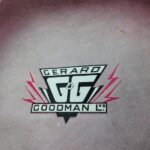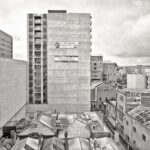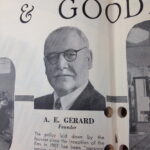After Alfred Gerard worked for electrical contractors Ellis & Clark, Gerard started his own business with a mere £100 loan from his father-in-law. Gerard originally worked from his rented house in Prospect. He was inspired to add his wife Elsie’s maiden name to his own surname to form the name Gerard and Goodman. Alfred Gerard’s business quickly became successful, and when five other men were working from his home, a pregnant Elsie insisted that they find another property for the work. The growing company moved several times: the men worked in JR Cattermole’s basement on 204 Rundle Street in 1907, on Twin Street in 1908, and on 100 Pirie Street in 1910 (where it expanded to encompass two additional adjacent shops). Alfred Gerard registered his company on 3 August 1908.
On 15 March 1912, Gerard and Goodman became incorporated and declared its nominal capital of £5 000; Mr LD Sobels became the company’s director. By 1915, Gerard and Goodman expanded to serve other cities in South Australia: Murray Pioneer and Australian River Record, based in Renmark, advertised the company’s services. Gerard and Goodman’s capital doubled in 1918. Upon Alfred Gerard’s development of adjustable, clip-on metal conduit fittings in 1920, the name ‘Clipsal’ was born because the fitting ‘clips all’. This invention helped Australian electrical contractors, who struggled to find fittings for metal conduits of varying sizes.
In 1925, Alfred Gerard’s son Hubert, who had worked in every division of the company, became a director of the company. Additionally, Mr RL Culley became Gerard and Goodman’s sales manager, bringing 14 years experience with him to the position. Despite the depression of the 1930s, Gerard and Goodman held a steady spot in Adelaide’s business scene: only in 1932 did the company record a financial loss. Company founder Alfred Gerard- and, by extension, Gerard and Goodman- emphasised the importance of excellent customer service. When the company was later sold to Gilbert Lodge, Anthony Gerard, general manager, compiled the Gerard & Goodman Standing Orders, which championed the four C’s of Character, Courage, Courtesy, and Capacity. Alfred Gerard also instilled in his sons and workers to eschew company glamour and instead prioritize solid communication and contact with manufacturers and suppliers.
His company fluorished with the help of his four sons, AH, WG, KE, and JH Gerard, managing two registered companies, on both of which Alfred was chairman of directors. Once Alfred’s son, Geoff, took leadership of the company, it made more breakthroughs, such as the first all-Australian switch in 1930 and the first use of thermoplastics in 1950. Gerard and Goodman went on to become Gerard Industries, which is now better known as Clipsal. This is one of the state’s biggest manufacturing companies and the main sponsor of the Clipsal 500 V8 races held annually in the East End, which is Australia’s largest domestic motorsports event.
Property Holdings
In 1921 Alfred Gerard purchased land on Synagogue Place, which was then surrounded by old houses. This was Alfred’s first purchase of a freehold property, and considered desirable because Synagogue Place could later extend to North Terrace- which never happened. Construction of a two-storey building six-metres wide began in 1922, and the company moved in in 1923. To help bolster Gerard and Goodman’s finances, Alfred Gerard sold some of his newly-acquired property to Adelaide Electric Supply Company. Later, Gerard would buy more property to give the Gerard and Goodman property a 19-metre frontage.
In 1925, Alfred Gerard arranged for the addition of two shops and a first floor connected to the original building. In 1928, the building added two more storeys to become a four-storey building with architects Woods, Bagot, Jory, and Laybourne-Smith. In the 20 April 1928 edition of News, the company announced
Although the foundations for the new building were put down suitably for erecting four stories, it was never thought that they would be needed, but in only four years these foundations were made use of, and the extra two floors have just been completed. The contractors are just moving offices from the ground floor to enable the showroom to be enlarged, and it can now be readily stated with confidence that Gerard & Goodman, Limited, have one of the best equipped electrical houses.
In 1937, Gerard and Goodman bought and occupied 192-196 Rundle Street; however, to pay for the new property, the company sold 132 Rundle Street in 1942. In the midst of the First World War in 1942, Gerard and Goodman, which had a war contract with the Commonwealth Government, received special wartime permission from the government to demolish its old building on Tavistock Lane, and to build a three-storey warehouse and workshop that was used to make heaters and to store orders from the Defence Department. In 1957, when a property adjacent to Gerard and Goodman on its northern side was put up for sale, the company purchased it and added another three-storey warehouse to its assets. After 1964, the company expanded even further with the purchase of a building on Tavistock Lane, adjacent to its only remaining building on Synagogue Place. In the 1960s, Gerard and Goodman had a store at 192 Rundle Street where Peregrine Travel Centre now stands.
Aboriginal Ties
Because of Alfred Gerard’s radical views that aboriginals and white Australians were equal, Gerard and Goodman served as a resource for aboriginals. By 1929, Alfred Gerard was the president of the United Aborigines’s Mission, which ran residential institutions focused on caring for and educating Aboriginal children and converting them to Christianity. In the 28 July 1929 edition of News, AE Gerard inquired readers to donate money so Aboriginal children at Colebrook Training Home in Quorn (run by missionary Matron R Hyde) could move to a larger building.
When the drought of 1943 negatively affected the aboriginal community, the United Aborigines’ Mission granted a request to house Arabunna children in Adelaide from 21 December 1943 to 31 January 1944. Gerard and Goodman stored beds, linen, and various home tools for the children staying in the city. this became a long-term act of generosity, as chronic water shortages at Quorn led the Minister of Public Works to lease what became the Colebrook Training Home at Eden. Gerard also had aboriginal workers at his company for apprenticeships, which was rare at the time.
10 July 1943’s issue of News stated that two aboriginal Australian men, George Tongerie and Alec Taylor, from Colebrook Mission Home would soon start training for the Royal Australian Air Force. Alec Taylor, who had been working at Gerard and Goodman for three years, would enter the Air Force as an electrician. Mr Hubert Gerard boasted that Mr Taylor was ‘smart, capable, [and] an enthusiastic church worker’.
Clients
Gerard and Goodman served a diverse body of clients and helped the city of Adelaide progress by supplying the latest technologies. By February 1911, census officials estimated the population of Greater Adelaide to be beween 190 000 and 200 000 people. This increase in population created a higher demand for entertainment venues, so King’s Theatre opened on King William Street South; Gerard and Goodman installed all of the electric lighting. In June 1912, the company installed electricity and manufactured custom fittings for the distribution boards in Adelaide’s Jubilee Exhibition Building, which was built to celebrate the forming of the South Australian colony through an international jubilee. In 1914, Gerard and Goodman set up electric lighting in the newly-constructed National Bank of South Australia on King William Street. Also in that year, in December, the company set up the electrical layout for an addition to the Young Women Christian Association’s building on Hindmarsh Square.
In April 1917, the Church of St Dominic in Clarence Park opened, where Gerard and Goodman put in electrical lighting. On Anzac Day in 1922, the Women’s Memorial, intended to honour the deceased soldiers of the First World War, was unveiled in Pennington Gardens. Gerard and Goodman managed the electricity used at the event.
On 21 November 1927, the Electric Light Committee of the Murray Bridge Corporation accepted Gerard and Goodman’s tender for a motor panel at its quarry.
In late 1938, a newly-formed company in Adelaide, General X-Ray Ltd., hired Gerard and Goodman to manufacture certain patented lines of their x-ray machines. General X-Ray Ltd. aimed to make x-ray machines at a price that country hospitals could afford.
Gerard and Goodman on Unions and Apprenticeships
The 6 September 1927 edition of The Advertiser explored the tensions between electricians working on the State Bank of South Australia and their employers that resulted when the electricians stopped working as a negotiating tool. The Advertiser failed to get comments from the Premier (who did not even know of the dispute), the secretary of the Employers’ Federation (Mr GH Boykett), Mr RW Bennett, KC (who was representing Unbehaun & Johnstone in taking the nonworking electricians to court), and Mr JJ Daly (counsel for electricians facing charges). However, Alfred Gerard of Gerard and Goodman spoke to The Advertiser on the issue:
The electrical work is proceeding at the State Bank, but not without threatenings. If the men were not getting their legitimate rights we would be the last to do anything that would not assist them. After carefully looking into the whole question we undertook a portion of the State Bank electrical installation, and immediately proceeded to carry out the work. I know the workers’ side perhaps better than most, having worked 12-hour shifts, and as hard as most men, and I know the value of unions, with which I am in hearty sympathy, but I am entirely out of sympathy with them as they are at present worked. We strongly believe in helping the masses irrespective of classes, but would convert the asses, who, true to their instinct, make trouble where none should exist.
AE Gerard had a similar view of company responsibility of workers when he spoke to an Advertiser reporter for its 22 July 1932 edition on the evolving state of apprenticeships during an economic depression:
Mr. A.E. Gerard, managing director of Gerard and Goodman, explained the reluctance of employers to engage apprentices on a five years’ term. No business man, he said, could see five years’ ahead at present. He suggested that boys could still receive their five years’ training if their period of probation were extended, and indentures applied only to the last three years of the period, when they would be from 18 to 22 years of age. These years were the most important, as the boy then became an expert.
Dr C Fenner, superintendent of secondary education and chairman of the Advisory Board of Apprentices, countered Gerard’s skepticism by emphasising the importance of an influx of new, skilled tradesmen to keep industries alive. Mr F Goring, also a member of the Advisory Board, added that three years would not suffice to train apprentices adequately, and that employers would suffer from a lack of experienced tradesmen if the term were reduced.
Local Community Involvement
In October 1914, Gerard and Goodman donated £3 3 to the South Australian Jockey Club’s efforts to raise money for the Mayor’s Patriotic Forces Fund, which served as war relief funds. Starting in 1924, Gerard and Goodman held annual picnics for their employees with sports contests.
On 21 October 1927, the Electrical Importers’ and Suppliers’ Association celebrated the forty-seventh anniversary of the invention of the birth of electricity with a social at Covent Garden Cafe. Mr AE Gerard attended to represent Gerard and Goodman at the event.
The November 1928 opening of East-End Market prompted business owners in the East End to form Rundle Street Traders’ Association. The first meeting of the association concerned the reputations of new stallholders in the East-End Market and the hiring of a band to play at the market every Friday night. The Association’s committee of management included Mr AE Gerard.
On 3 December 1928, an Electrical Trades Luncheon took place at the South Australian Hotel, where members of the visiting British Economic Delegation were guests. AE Gerard attended the event.
For the 1929 annual company picnic, employees went to the company premises and were transported by car to the National Park in Belair, South Australia. The day’s programme included cricket and tennis matches, and running and wheelbarrow races.
During the Second World War, South Australia welcomed many refugees from wartorn countries. The 14 November 1939 issue of The Advertiser shared that staff at Gerard and Goodman had donated a total of £4 11/2 to the Red Cross to help these refugees.
Natives of Adelaide saw a turning point in South Australian history on 30 May 1949, as the state had its very first own television broadcast. The Shell Company sponsored this event, as the manager of the South Australian branch, Mr TW Martin, greeted his viewers from Freemasons Hall on North Terrace. By buying a ticket, people could witness Mr TW Martin in person as he made his television debut. Gerard and Goodman’s Rundle Street store window displayed this historic broadcast, and a crowd soon gathered. The sum of the ticket profits, and a donation of 20 guineas from Gerard and Goodman, were split in half to make a £204 contribution each to the Legacy Club and Adelaide Children’s Hospital.
Gerard and Goodman joined other electronic and technology companies in attending Amateur Radio Field Day on Kulpara sports ground on 29 October 1950. That day, people participated in sports and technology contests; winners won cash prizes from companies present.
Gerard and Goodman’s Overseas Connections During the Second World War
Keep Brothers Ltd. of Birmingham, England, sent a letter to their Australian colleagues at Gerard and Goodman that addressed their office building’s damage after a bombing. Keep Brother’s letter was published in the 19 December 1940 issue of News:
Fortunately, the damage done to our premises is not sufficiently serious to prevent our carrying on, and business was actually suspended for only 24 hours. Today we are once more back at our desks, and although a good part of the roof above our heads has disappeared we have been able to make such arrangements as permit us to resume work in all departments. Coming on top of the disorganisation of the postal, telegraph, and telephone services, we are naturally somewhat handicapped, but we are sure that our friends abroad will sympathise with us in our misfortune and will pardon us if temporarily our activities are not quite all we could wish.
Growing Prestige and International Presence
On 12 December 1925, a weeklong Railway Radio Show festival opened at the Railway Institute; Gerard and Goodman had an exhibit, and was included in News‘ list of ‘Interesting Exhibitions’ in their coverage. In January 1927, company founder Alfred Gerard took a business trip to Great Britain and the United States to increase his company’s international presence. Later that year, on 21 September, steamer SS Carignano sailed for Genoa, Italy, with Gerard and Goodman products on board for later sale.







Comments